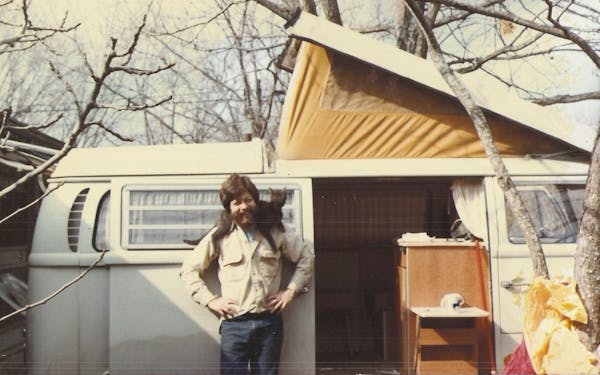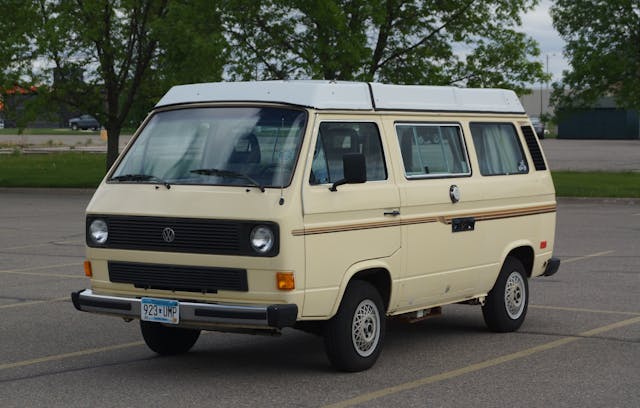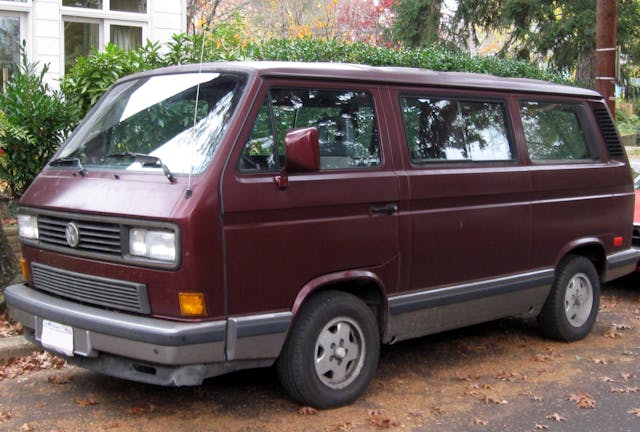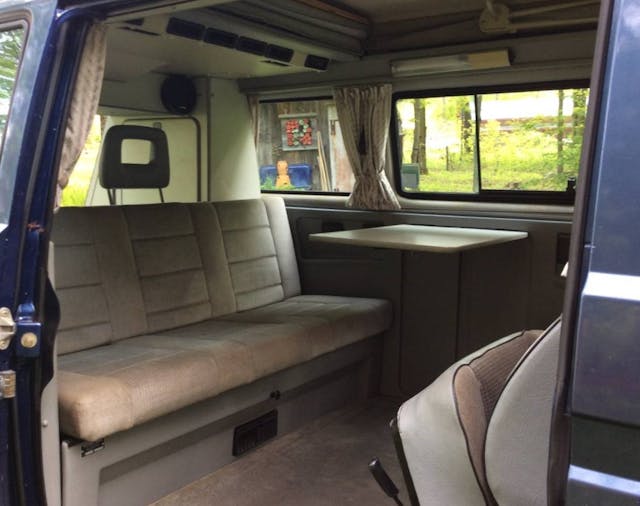Media | Articles
My long (and nearly forgotten) Vanagon chapter

My automotive life has been painted mainly with brushstrokes of 1970s-era BMWs used as enthusiast cars, and whatever low-priced, high-mileage, standard-transmission BMW crossed my path and found itself as a daily driver for a few years. There was also a succession of a half-dozen Suburbans used as vacation/beach-assault/tow vehicles. And a Volvo wagon and two minivans that hauled the family around. And, of course, there were the Brit bookends, the Triumph GT6+ I had after high school, and, after taking 35 years to recover from that experience, the Lotus Europa I still enjoy more than I have a right to.
There were also the four Volkswagen Vanagons. I’d almost forgotten about that entire Vanagon chapter of my automotive life until recently, when Hagerty included Vanagon campers on its 2021 Bull Market list.
First, we need to give credit where credit is due. After Chrysler rolled out the Plymouth Voyager/Dodge Caravan in 1984, it was widely spun that it had invented the minivan, but it’s simply not true. If the term “minivan” referred to a vehicle that could seat seven adults in full-sized forward-facing seats, had both a rear hatch and a sliding side door, allowed the driver to walk inside the vehicle from front to back, and could fit in a small garage (indeed, the term first used in the ’80s was “garage-able minivan”), the ubiquitous Volkswagen bus/van had already been doing that for decades. (And a quick bit of nomenclature: All VW vans, regardless of generation, are called “Type 2s,” but the early split-windowed “microbuses” are referred to as T1s; the 1968–79s versions are T2s; Vanagons are T3s; and Eurovans are T4s.)
It’s important to appreciate that, in the mid-1980s, the walk-inside-the-vehicle thing was the feature that attracted young parents to minivans, as it allowed them to open the side door, put infants and small children in car seats, slide the door shut behind them, then seat themselves in front without getting out of the vehicle, and repeat this in reverse when exiting. This was enabled by a design that included both a raised roof line and a flat floor. Achieving the flat floor required getting rid of the transmission hump that accompanied what was then the standard American car configuration of front-mounted engine and rear-wheel drive. While Chrysler does deserve credit for being the first to achieve this in a minivan via front-wheel drive with a transverse-mounted engine and transaxle (no more center-mounted transmission and driveshaft running to the rear wheels), Volkswagen had, in fact, fulfilled the same requirement decades ago via the rear-mounted engine design.
I think it’s the way we remember VW buses that accounts for them not being thought of as the first minivans. It’s funny; on the one hand, the pre-1968 Volkswagen split-windshield T1 was called a “microbus” precisely because it had three rows of seating, but it’s now fixed in our collective mind as a piece of dayglo counterculture kitsch. Although it increased in size and got the sliding door in 1968 and was sold in the U.S. in that T2 configuration through 1979, even the idea that it might have been something so conventional as a family hauler seems laughable. And, as someone who personally watched several members of his family get out of a fully packed VW bus because, with all of us in it, it wouldn’t make it up a hill, perhaps that’s fair. Plus, the fact that the Type 2 was also available as a wanderlust-inducing Westfalia camper—the mental antithesis of a soccer mom vehicle—also made it less likely to be thought of as fulfilling the same role as a “minivan.”
Marketplace
Buy and sell classics with confidence
My wife and I had two T2 busses. The first was a rusty ’71 that she bought before we got married. It had the 1600 engine with dual-ported heads, good for 51 horsepower. We did what many young people did with the bus, which was to yank out the middle seat and build a bed platform. When the rust became so bad that a bottle jack went through the frame rail, I found a ’69 Westfalia camper with a blown engine and put the good engine in the camper. We drove it until we had kids, at which point its age and general condition and concerns about seat belt attachments for the infant seats became a problem.

With that history, it perhaps wasn’t surprising that my first post-kids minivan was a Volkswagen T3 Vanagon.
Vanagons divide up primarily into the 1980–83 air-cooled cars that use the same 70-hp, 2.0-liter, Bosch L-Jetronic, air-cooled, flat-four engine that the 1975–79 T2 bus had, and the later 1984–91 cars with the “water boxer” (or “wasserboxer”) engine, which was a flat-four with water-cooled heads. You can tell the difference at a glance, as the air-cooled cars all have one row of grilles around the headlights, whereas the water boxer-equipped cars have a second row of grilles to allow air flow into the front-mounted radiator.

Within the water-cooled cars, there are early and late ones. The 1983–85 cars have round headlights like the air-cooled cars and an 80-hp, 1.9-liter, water-boxed engine with Digijet injection.

From ’86 through the end of production, Vanagons got a slight facelift with square headlights, and the engine changed to a 90-hp, 2.1-liter water-boxer with improved cooling, running Digifant engine management with computer-controlled spark advance.

There were quite a number of model designations and options over the years—see www.vanagons.org to sort them out—but the main three that rose above simple trim differences were the Westfalia camper, the Weekender Package, and the Syncro.
The iconic Westfalia camper features a two-person rear bench seat that folds out into a bed, a pop-top with a thin fold-out bed appropriate for two children, two swing-out tables, water tank and sink, propane tank and stove, refrigerator, cabinet space, 120VAC outlets for campground hook-up, and curtains. It’s cool, but the camper-specific amenities cut into the interior space and limits the people-and-cargo-hauling versatility of the van. So, beginning in 1985, Volkswagen began offering a Weekender Package, where the rear bench seat folds forward into a bed when combined with a cushion over the engine compartment, the middle seats face rearward, and both sets of seats surround a centrally located flip-up table. In other words, a Vanagon you can sleep in and eat pizza in without it being a camper.

And now, the confusing part. Unlike the pop-top Westfalia camper, I don’t believe the Weekender was ever technically a model designation. When introduced, it was an option on the hardtop vans, but then, puzzlingly, it also became available on the Westfalia Wolfsburg Edition, which was a model. Worse, Wolfsburg editions of both the camper and the hardtop became available, and what was in them varied year to year. I think that the best way to think about the Weekender Package is that, for the hardtop, it was an addition, whereas for the camper, it was a take-away. That is, when a hardtop has it, it gains the fold-out bed and table, but when a pop-top camper has it, it loses the kitchen and most of the cabinets.
To increase the confusion, in 1990 the Wolfsburg Edition and Weekender Package went away and bifurcated into the Multivan (MV) pop-top and the Carat hardtop, which both had the bed and flip-up table. So, if you read an ad for “Westfalia Weekender,” it should be a pop-top without the kitchen, but if the just says “Weekender” or “Wolfsburg,” it could be either a pop-top or a hard-top. For more detail, see this and other excellent articles on GoWesty.com.

Beginning in 1984, the Syncro four-wheel drive package—which used a viscous coupling to divide power between front and rear and had increased ground clearance—became available. Note that you could get Syncro full Westfalia campers, Syncro Westfalia Weekenders, and Syncro hardtop Weekenders, but apparently the Syncro package was not available with the Multivans and Carats.

The first Vanagon I bought was a 1980 base model, purchased in about 1988. Some buyer’s guides say that these air-cooled Vanagons are the worst years of the bunch, as they used the same 70-hp engine as the 1979 T2 they replaced, but the engine wasn’t up to the task of moving the bigger, heavier T3. However, my memory is that, compared with our ’69 Westfalia and its 51-hp engine, the Vanagon felt downright quick. Plus, having owned two air-cooled T2s, I felt very comfortable working on it.
The Vanagon dwarfed any other minivan in terms of interior space. Chrysler made a big deal about the Voyager’s seating for seven, but what it didn’t say was that you could use the third seat or have cargo space under the hatch, but not both. When deployed, that third seat was right up against the hatch; you could barely fit two bags of groceries back there. In contrast, because the Vanagon’s engine was in the back, the engine compartment naturally provided the backstop for the rear seat, and behind it was a cavernous space (at least compared with any other minivan), which also had the lift-up access panel to the top of the engine. And if you took out the middle seat, you could fit just about anything. At the time, my wife and I were in a band, and the way the Vanagon could move the family by day, and swallow her drums, my guitars and amp, plus a pair of Electrovoice Eliminator PA speakers, each nearly the size of a washing machine, by night, was enormously satisfying. Boy, what a great vehicle to use to run out and buy a set of used wheels and tires, a pair of Recaros, and a transmission.
But the other cool thing was that, if you were into air-cooled Volkswagens, the Vanagon was simply the biggest newest one. Yes, it had room to beat the band (literally in my case), but in addition, it had all the familiar sounds and smells of a VW. That “packed” engine sound. Heat that (when it worked) always smelled slightly of oil and exhaust. And that unmistakable German-ness.
The band stuff wound down, the Vanagon began rusting (seam rust is a real problem on these cars), so we sold it and replaced it with a Volvo 245GLT wagon, but not long after I ran into another 1980 Vanagon, this one a Westfalia camper, for a song. My wife and I had nostalgia for our previous Westy, so I bought it. We took the kids on one overnight, but not long after, we bought our first house, and the camper was among a number of vehicles that got sacrificed to the down payment god.
Vanagon no. 3 was a real oddball. In 1982 and ’83, Volkswagen offered a diesel Vanagon. It used the same 48-hp, 1.6-liter engine as the diesel Rabbit. For $500, I was curious, so I bought it. It is impossible to exaggerate how slow this thing was. Even by T1 and T2 standards, where you’re used to traffic backing up behind you, it was insane. Hot VWs magazine reportedly quoted the 0–60 time as 41.1 seconds. And yes, its rear bumper was bashed in like every other unrestored T1 and T2 you’ve ever seen. When my sister’s Plymouth Voyager died (how ironic), I gave it to her. She and her husband had four kids and used it during the winter of 1994 for local running around, then bought something more sensible.

By the mid-1990s, my wife was happily driving her Toyota Previa, so I couldn’t pretend that I was still looking at Vanagons for the family; it had become an odd passion, sort of a yang to the BMW’s yin. Vanagon no. 4 looked promising. It was a late car, an ’89 square-headlight water-boxer, good overall condition, ran but was weeping coolant from corrosion on one of the heads (a common problem). I bought it and planned to pull the heads and have them done, but it was winter and I lacked the garage space. Then, while my daily driver needed work, I drove the Vanagon one time too many, the engine made an expensive sound and died, I was insanely busy with work and life, and I got rid of it. It was one of the only times I bailed out of a project.
The Vanagon craving went quiet for a decade, but then in the mid-2000s, it burbled back to the surface. Since none of the stock Vanagon powerplants are great, the idea of putting an air-cooled Porsche 911 engine into one always had been the white whale to the Vanagon’s Ahab (that is, you obsess about it, then it kills you and the car and your bank account). But I began reading about a different approach: Take one of the later Vanagons that already has the plumbing for a water-cooled engine and put a Subaru engine in it. Those engines are also water-boxers, so the configuration is similar.
Then I saw something that grabbed me hard—a conversion using the 230-hp flat six from a Subaru SVX, the “see, we can build a sports car” coupe that sold from 1992–97. Buying a used SVX engine was nowhere near the cost of a 911 engine. There were companies that would sell you an entire conversion package, or you could buy the engine mounts, wiring harness, adapter plate, oil pan, cooling system adaptations, exhaust, and other bits a la carte.
I was obsessed with it for a while, thinking that if I found the right car, like a late Wolfsburg Weekender, or even better, a Carat with both the wrap-around cladding and slightly-lowered stance, and if it was cheap due to needing engine work, I’d make something happen. My wife was kind of mystified, offering, “I thought we both liked nice hotel rooms, and that our days of sleeping in cars were over.” She had a point, but this was a different kind of passion. I drove to upstate New York to look at a Wolfsburg hardtop with a dead engine, but the seller and I couldn’t agree on price.

Then, I saw a red Vanagon Carat needing engine work advertised in nearby Rhode Island for a drop-everything price. I called the seller; it sounded perfect, I said I was on my way with cash and begged him not to sell it out from under me. He laughed at the implausibility that that could happen within an hour. I drove down, saw the car in the parking lot, couldn’t believe my good fortune, called him to tell him I was there, and learned that … he’d sold it out from under me. After that, all the Vanagon-related air went out of my sails. I began asking myself reasonable questions like “What would I actually use this car for?” and “It’ll rust if it’s left outside; do you really want to allocate a precious garage space to a Vanagon?” It forced me to shush my passion and decide whether I really wanted to commit to having a Vanagon as an enthusiast car. The answer was no. And that was that.
About a decade later, my wife and I bought our Winnebago Rialta, which is a Volkswagen T4 Eurovan with a Winnebago RV body on the back. It sort of looks like a Eurovan with its rear three-quarter section puffed up like a blowfish. If you don’t know, the dividing line between an RV like the Rialta and a camper like a Westfalia is than an RV has a bathroom and a camper doesn’t. As I’ve written, owning a small RV with a bathroom is incredibly handy; we can load our bikes on the back, take them on a rail trail, and have someplace comfortable to return to at the end of the ride.
As Hagerty noted in its Bull Market list, the Vanagons that bring the big coin are the full-on Westfalia campers, especially those with the Syncro package—so owners can rock-crawl to remote parts of Moab, or at least imagine doing so. The Syncros, with their cuffs-pulled-high-over-their-ankles look, never really did anything for me. And with our Rialta working so well for us, it’s really difficult to see where any Vanagon in van, Weekender, or camper configuration would really fit into our lives, so it’s tough to imagine buying one even if I found a steal.
Still, when I see one driving around, especially a later Carat with the slightly hunkered-down suspension, the wrap-around cladding, and the little air dam on the front, I wonder who owns it, what they use it for, and think, “Damn that would be fun with an SVX engine in it.” If nothing else, I hope they find a good deal on a used set of wheels and a pair of Recaros.
***
Rob Siegel has been writing a column (The Hack Mechanic™) for BMW CCA Roundel magazine for 34 years and is the author of seven automotive books. His new book, The Lotus Chronicles: One man’s sordid tale of passion and madness resurrecting a 40-year-dead Lotus Europa Twin Cam Special, is now available on Amazon (as are his other books), or you can order personally-inscribed copies from Rob’s website, robsiegel.com.






Fun article. When I got out of the Navy in ’69, I bought a 1959 split-window VW for $1,000…imagine! 6 volt, step-down gears from the transaxle to the wheels, red line at 49 mph. The interior had been worked on by the former owner…fold-down bed with wood panelling overhead and inside. Icebox for a fridge. I drove it from Santa Monica up the coast to Vancouver, across Canada to New Brunswick, down to Virginia and then back across the U.S. Leisurely. I eventually sold it for what I had paid for it. I wonder where it is now.